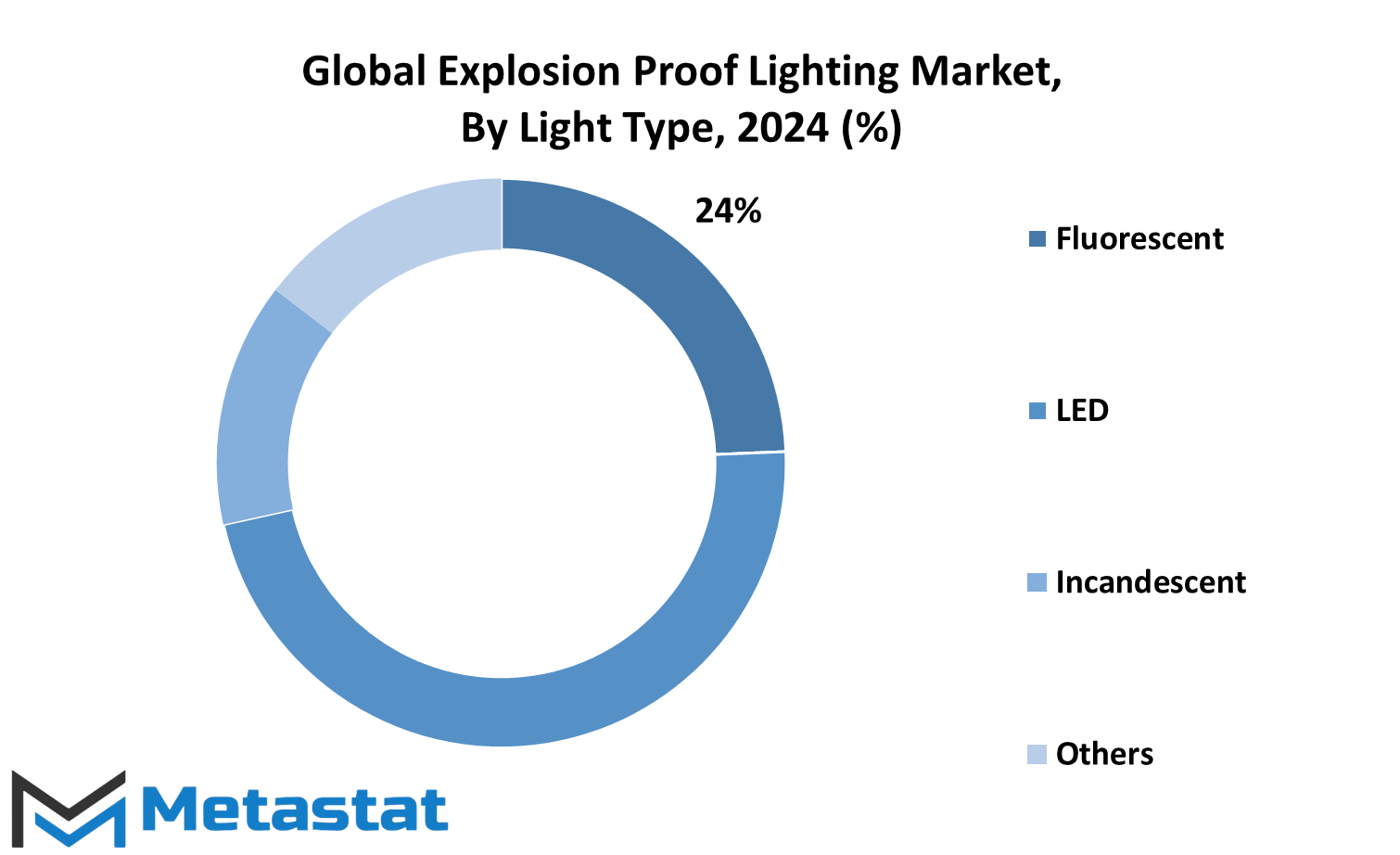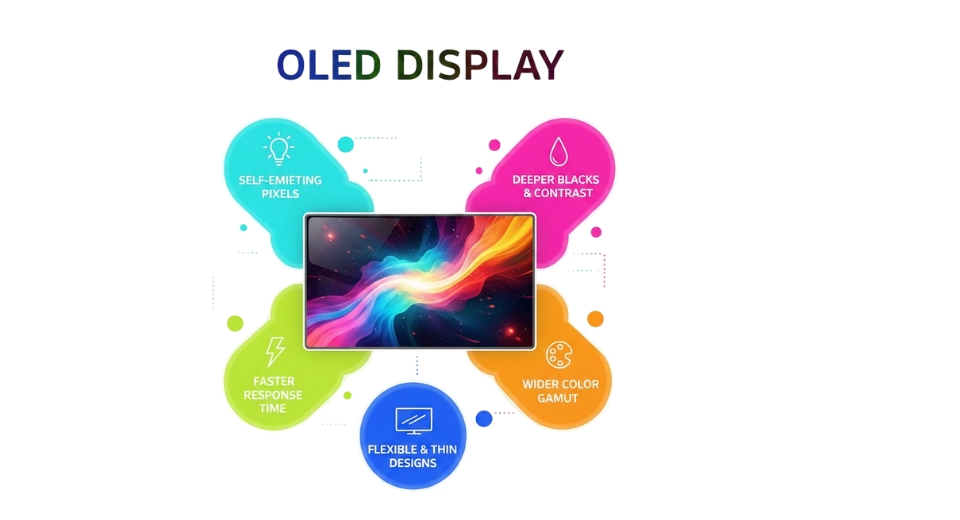MARKET OVERVIEW
The Global Explosion Proof Lighting market plays a critical role in industries where safety and reliability are paramount. This specialized sector focuses on developing lighting solutions that can operate safely in hazardous environments, such as those found in oil and gas, mining, chemical processing, and manufacturing. These environments often contain flammable gases, vapors, dust, or fibers that can ignite if exposed to standard electrical equipment, making explosion-proof lighting essential for preventing accidents and ensuring continuous operation.
In the context of the Global Explosion Proof Lighting market, innovation and technology advancements drive the development of robust and durable lighting solutions. Manufacturers are continually researching and designing lights that can withstand harsh conditions without compromising on performance. These lights are engineered to prevent any internal spark or explosion from escaping the fixture, thereby avoiding any ignition of surrounding hazardous substances. The design often includes heavy-duty materials and meticulous construction methods to ensure that the lights remain functional and safe under extreme conditions.
One of the significant applications of explosion-proof lighting is in the oil and gas industry. This sector demands reliable lighting solutions for offshore platforms, refineries, and pipelines, where the presence of volatile compounds poses a constant risk. Similarly, the mining industry relies on explosion-proof lighting to ensure safe operations deep underground, where explosive gases and dust are prevalent. Chemical plants and manufacturing facilities also depend on these lights to maintain safe working environments, preventing potential disasters that could result from electrical sparks.
As industries continue to prioritize safety, the demand for explosion-proof lighting is expected to grow. Regulatory standards and safety protocols will likely become more stringent, pushing manufacturers to innovate and improve their products continuously. In addition to safety, there is a growing emphasis on energy efficiency and environmental sustainability. Companies are increasingly looking for explosion-proof lighting solutions that not only meet safety requirements but also contribute to reducing energy consumption and carbon footprint.
The integration of smart technology into explosion-proof lighting systems is another trend shaping the market. Smart lighting solutions offer enhanced control, monitoring, and automation capabilities, allowing for better management of lighting in hazardous environments. These systems can be integrated with other safety and operational systems to provide real-time data and alerts, improving overall safety and efficiency.
Geographically, the Global Explosion Proof Lighting market is expanding, with significant growth potential in regions with extensive industrial activities such as North America, Europe, and Asia-Pacific. Emerging economies are also witnessing increased industrialization, which is expected to drive the demand for explosion-proof lighting solutions. Market players are focusing on expanding their presence in these regions through strategic partnerships, mergers, and acquisitions to tap into the growing opportunities.
The Global Explosion Proof Lighting market is an essential component of various industries where safety cannot be compromised. The ongoing advancements in technology, coupled with increasing regulatory demands and a focus on sustainability, will continue to drive innovation and growth in this sector. As industries evolve and new challenges emerge, explosion-proof lighting will remain a critical area of focus, ensuring that hazardous environments are illuminated safely and efficiently.
Global Explosion Proof Lighting market is estimated to reach $3351 Million by 2031; growing at a CAGR of 7.24% from 2024 to 2031.

GROWTH FACTORS
The Global Explosion Proof Lighting market is poised for significant growth in the coming years due to several key factors. One of the primary drivers of this growth is the increasing emphasis on safety regulations across various industries such as oil & gas, mining, and chemical manufacturing. As safety standards become more stringent, businesses are compelled to invest in explosion proof lighting solutions to mitigate the risk of accidents and comply with regulatory requirements.
Furthermore, there is a growing awareness of the importance of workplace safety, which further fuels the demand for explosion proof lighting. Employers recognize the need to provide a safe working environment for their employees, and investing in explosion proof lighting is seen as a crucial aspect of achieving this goal.
Despite the promising growth prospects, there are certain challenges that could impede the market's expansion. High initial costs associated with explosion proof lighting systems can act as a deterrent for some businesses, particularly smaller enterprises with limited financial resources. Additionally, the complex installation requirements of these systems may pose logistical challenges for companies, further complicating the adoption process.
Moreover, the shortage of skilled technicians capable of installing and maintaining explosion proof lighting systems presents another obstacle to market growth. As businesses struggle to find qualified professionals to handle these specialized tasks, it can hinder the widespread adoption of explosion proof lighting solutions.
However, amidst these challenges, there are opportunities for market players to capitalize on. Advances in LED technology have led to the development of more energy-efficient explosion proof lighting products, which not only reduce operational costs but also contribute to sustainability efforts. These technological innovations are expected to drive demand for explosion proof lighting in the coming years, presenting lucrative opportunities for market growth.
The Global Explosion Proof Lighting market is poised for substantial growth driven by increasing safety regulations, growing awareness of workplace safety, and technological advancements. While challenges such as high initial costs and skilled labor shortages may pose temporary setbacks, the market is expected to capitalize on opportunities presented by advancements in LED technology and energy-efficient lighting solutions.
MARKET SEGMENTATION
By Type
The Global Explosion Proof Lighting market is categorized into various types, including Flash Lights, Wearable Lights, Panel Lighting, and Others. These segments represent different forms and applications of explosion-proof lighting solutions designed to ensure safety in hazardous environments.
Flash Lights are portable lighting devices that emit a bright beam of light and are typically used for illumination in confined spaces or during emergency situations. They are compact, easy to carry, and provide instant illumination when needed. Wearable Lights, on the other hand, are designed to be worn by individuals, such as headlamps or safety vests with built-in lighting. These hands-free lighting solutions offer convenience and mobility, allowing workers to perform tasks efficiently while maintaining visibility in hazardous areas.
Panel Lighting refers to large lighting fixtures that are installed on walls or ceilings to provide uniform illumination across a wide area. These fixtures are commonly used in industrial settings where large spaces need to be illuminated for extended periods. Panel lighting is durable, energy-efficient, and suitable for use in environments where there is a risk of explosion.
The category labeled as Others encompasses various types of explosion-proof lighting solutions that may not fit into the specific categories mentioned above. These could include specialty lighting fixtures designed for specific industrial applications or innovative lighting technologies that are still emerging in the market. The inclusion of this category allows for flexibility in accommodating new developments and advancements in explosion-proof lighting technology.
Each type of explosion-proof lighting serves a unique purpose and offers distinct advantages depending on the specific requirements of the environment in which it is used. For example, Flash Lights are ideal for emergency situations or temporary lighting needs, while Wearable Lights provide hands-free illumination for workers performing tasks in hazardous areas. Panel Lighting, with its wide area coverage and durability, is well-suited for large industrial facilities, while the category of Others caters to specialized lighting needs and emerging technologies.
By Light Type
The Global Explosion Proof Lighting market is seeing significant growth, with various types of lights contributing to this expansion. These lights include Fluorescent, LED, Incandescent, and others. Each type has its own unique features and benefits, catering to different needs and preferences in various industries and applications.
Fluorescent lights, known for their energy efficiency and brightness, have been widely used in industrial settings for years. However, as technology advances, LED lights are gaining traction in the market due to their superior energy efficiency, longer lifespan, and durability. LED lights also offer better light quality and can withstand harsh environments, making them ideal for hazardous locations where explosion-proof lighting is required.
Incandescent lights, although less energy-efficient compared to fluorescent and LED lights, still have their place in the market. They provide a warm, familiar glow and are often used in applications where aesthetics are important or where specific lighting requirements need to be met.
Apart from these main types, there are also other types of explosion-proof lights available in the market. These may include halogen lights, HID (high-intensity discharge) lights, and xenon lights, among others. Each type has its own advantages and is suitable for specific applications based on factors such as brightness, color temperature, and environmental conditions
As industries continue to evolve and technology advances, we can expect further innovations in explosion-proof lighting. Manufacturers will likely focus on improving energy efficiency, durability, and performance to meet the growing demands of various industries, including oil and gas, mining, chemical, and manufacturing.

By End-User
The Global Explosion Proof Lighting market is witnessing significant growth, with various industries driving its expansion. Among these industries are Oil and Gas, Chemical and Pharmaceutical, Food and Beverages, Mining, Energy and Power, and Others. These sectors are propelling the demand for explosion-proof lighting solutions to ensure safety in hazardous environments.
One of the key drivers behind the surge in demand for explosion-proof lighting is the increasing awareness and emphasis on workplace safety. Industries operating in hazardous locations, such as oil refineries, chemical plants, and mining sites, are mandated to implement safety measures to prevent accidents. Explosion-proof lighting plays a crucial role in minimizing the risk of fire and explosion in these environments, thereby safeguarding both personnel and property.
Moreover, the rise in industrialization and infrastructure development across the globe is fueling the demand for explosion-proof lighting systems. As more industrial facilities are being established, the need for reliable lighting solutions that can withstand harsh and potentially explosive atmospheres becomes paramount. This trend is particularly evident in emerging economies where rapid industrial growth is taking place.
Furthermore, advancements in technology are driving innovation in the explosion-proof lighting market. Manufacturers are continuously developing new and improved lighting fixtures that offer enhanced durability, efficiency, and safety features. LED technology, in particular, has gained traction in this market due to its energy efficiency and long lifespan, making it a preferred choice for industrial applications.
Additionally, stringent regulations and standards governing workplace safety are compelling industries to invest in explosion-proof lighting solutions. Regulatory bodies and industry associations have established guidelines for the design, installation, and maintenance of lighting systems in hazardous locations to mitigate the risk of explosions and ensure compliance with safety standards.
REGIONAL ANALYSIS
The global market for Explosion Proof Lighting is categorized into different regions based on geography. These regions include North America, Europe, Asia-Pacific, South America, and Middle East & Africa.
North America is further divided into three main countries: the United States, Canada, and Mexico. In Europe, the market encompasses the United Kingdom, Germany, France, Italy, and the rest of Europe. Meanwhile, the Asia-Pacific region consists of India, China, Japan, South Korea, and the rest of Asia-Pacific.
Moving on to South America, the market includes Brazil, Argentina, and the rest of South America. Lastly, the Middle East & Africa region is divided into GCC Countries, Egypt, South Africa, and the rest of Middle East & Africa.
Each of these regions will have its own unique characteristics and factors influencing the demand for explosion-proof lighting solutions. Factors such as industrial growth, government regulations, and infrastructure development will play a significant role in shaping the market dynamics in each region.
For example, North America, particularly the United States and Canada, is expected to witness significant growth due to the presence of a mature industrial sector and stringent safety regulations. Similarly, Europe, with its focus on sustainability and energy efficiency, will drive the demand for explosion-proof lighting solutions.
In contrast, the Asia-Pacific region, led by countries like China and India, will experience rapid industrialization and urbanization, leading to increased demand for explosion-proof lighting in hazardous environments such as manufacturing plants, oil refineries, and chemical facilities.
South America and the Middle East & Africa regions will also witness steady growth, fueled by investments in infrastructure development and the expansion of industries such as oil & gas, mining, and petrochemicals.
Overall, the regional analysis provides valuable insights into the diverse market landscape of the global Explosion Proof Lighting market. Understanding the specific dynamics and trends within each region will be crucial for businesses operating in this industry to develop effective strategies and capitalize on emerging opportunities.
COMPETITIVE PLAYERS
The global market for Explosion Proof Lighting sees a bustling arena of competitive players. These players are the driving force behind the industry's growth and innovation. Among them, notable names include NORKA Lighting, Cooper Industries (Eaton), Phoenix Lighting, Philips Lighting, Hubbell Incorporated, WorkSite Lighting, FeiCe, Bals, Shenzhen KHJ, LDPI, Bosch, Chamlit Lighting, Victor Lighting, Boss LTR, and ABB Ltd.
Each of these companies brings its unique strengths and strategies to the table. They compete not just in terms of the products they offer but also in areas such as technological advancements, customer service, and market reach. This competition fosters a dynamic environment where innovation thrives, ultimately benefiting consumers with better products and services.
NORKA Lighting, for instance, is known for its commitment to quality and reliability. Cooper Industries (Eaton) stands out for its wide range of offerings catering to various industrial needs. Phoenix Lighting is recognized for its cutting-edge solutions in hazardous environments. Philips Lighting, a well-established name in the lighting industry, continues to push boundaries with its innovative designs and energy-efficient solutions.
Hubbell Incorporated, WorkSite Lighting, FeiCe, Bals, and others also play significant roles in shaping the market landscape. They leverage their expertise and resources to stay ahead in the competition, constantly seeking new opportunities for growth and expansion.
In this competitive scenario, companies must stay agile and adaptable to navigate the ever-changing market dynamics. Technological advancements, regulatory changes, and shifting consumer preferences are some of the factors that can influence the competitive landscape.
For example, as the demand for energy-efficient lighting solutions grows, companies may need to invest more in research and development to stay relevant. Similarly, stricter safety regulations in various industries may create opportunities for companies specializing in explosion-proof lighting solutions.
Moreover, globalization has opened up new avenues for expansion, with companies looking to tap into emerging markets and diversify their product portfolios.
Overall, the competitive players in the Explosion Proof Lighting market will continue to drive innovation and growth, shaping the industry's future trajectory. By staying responsive to market trends and customer needs, these companies will remain at the forefront of the industry, driving progress and delivering value to stakeholders worldwide.
Explosion Proof Lighting Market Key Segments:
By Type
- Flash Lights
- Wearable Lights
- Panel Lighting
- Other
By Light Type
- Florescent
- LED
- Incandescent
- Others
By End-User
- Oil and Gas
- Chemical and Pharmaceutical
- Food and Beverages
- Mining
- Energy and Power
- Others
Key Global Explosion Proof Lighting Industry Players
- NORKA Lighting
- Cooper Industries (Eaton)
- Phoenix lighting
- Philips Lighting
- Hubbell Incorporated
- WorkSite Lighting
- FeiCe
- Bals
- Shenzhen KHJ
- LDPI
- Bosch
- Chamlit Lighting
- Victor Lighting
- Boss LTR
- ABB Ltd.
WHAT REPORT PROVIDES
- Full in-depth analysis of the parent Industry
- Important changes in market and its dynamics
- Segmentation details of the market
- Former, on-going, and projected market analysis in terms of volume and value
- Assessment of niche industry developments
- Market share analysis
- Key strategies of major players
- Emerging segments and regional growth potential








 US: +1 3023308252
US: +1 3023308252






